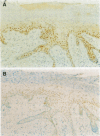Abstract
AIM: To elucidate the role of the p53 tumour suppressor gene in the pathogenesis of lip cancer. METHODS: Expression of p53 was evaluated immunocytochemically in a retrospective study of formalin fixed, paraffin wax embedded tissue. Five cases each of four types of lip lesions were studied; these comprised squamous cell carcinoma (SCC), solar keratosis (SK), chronic hyperplastic candidosis (CHC), and lichen planus (LP). Five cases each of normal lip mucosa, SCC, and SK from sun exposed facial skin as well as LP, CHC, and SCC from buccal mucosa were also analysed. Immunolocalisation of p53 was scored semiquantitatively. The degree of apoptosis was also assessed in selected lesions by determining cell nuclear fragmentation. RESULTS: All SCCs from lip lesions were immunopositive for p53. All cases of SK and two of five CHC lip lesions were also p53 positive. Normal lip mucosa samples were p53 negative. Sun exposed skin lesions of SCC and SK were all positive for p53, but only three of five cases of SCC from the buccal mucosa had detectable levels of p53. p53 expression was not detected in CHC and LP lesions of the buccal mucosa. CONCLUSIONS: The aberrant expression of p53 is likely to occur early in the pathogenesis of lip cancer and may be related to exposure to the sun. The immunopositive p53 cells identified in the benign LP lesions do not necessarily correlate with commitment of cells within the lesion to programmed cell death. In light of the prior reports which indicate that p53 positive cells may progress to form malignant tumours, it is suggested that patients with p53 positive but otherwise benign lesions should be followed more closely.
Full text
PDF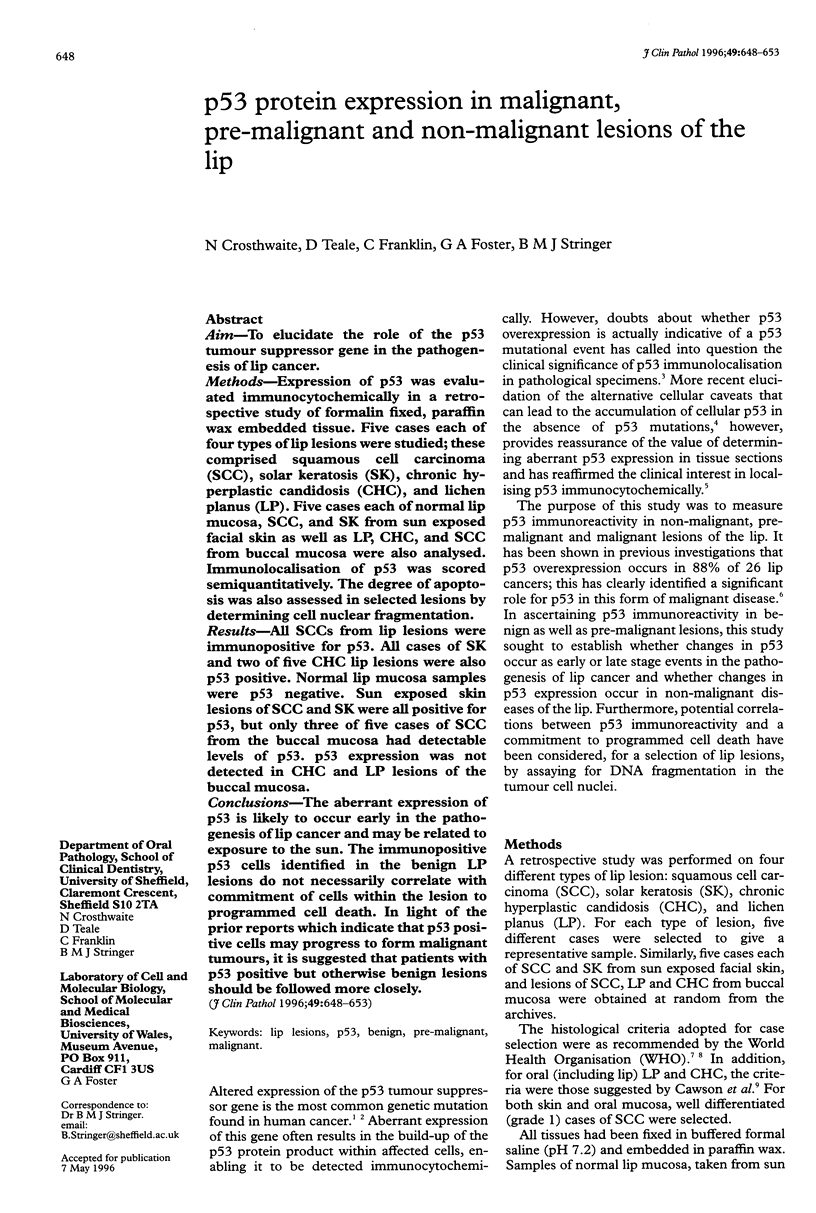
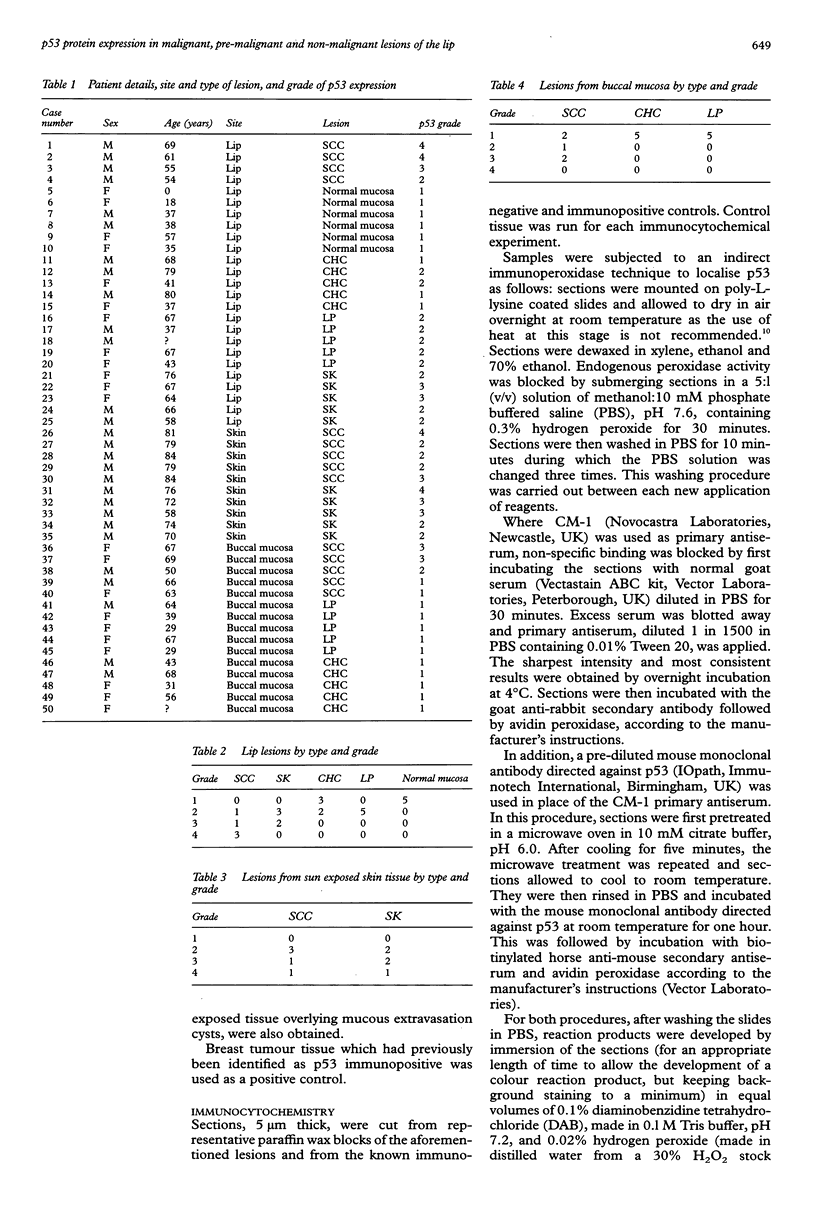
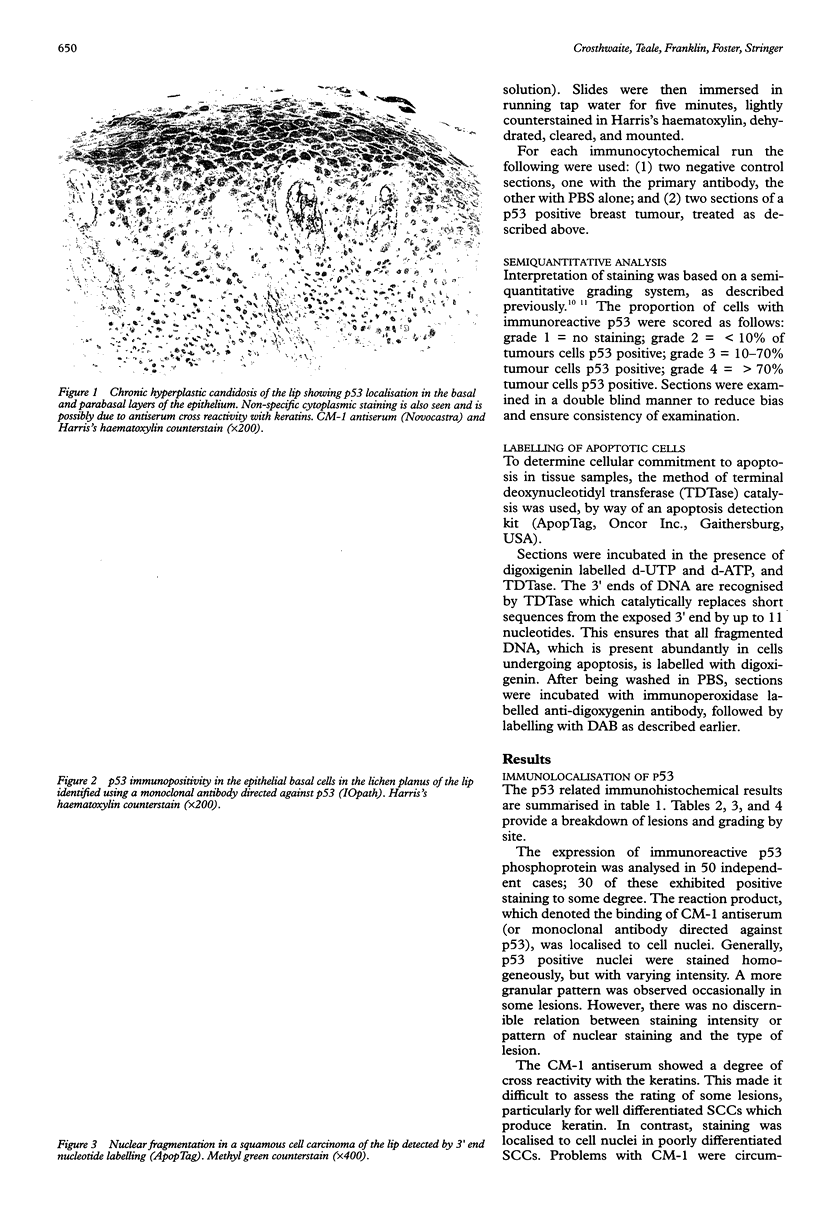
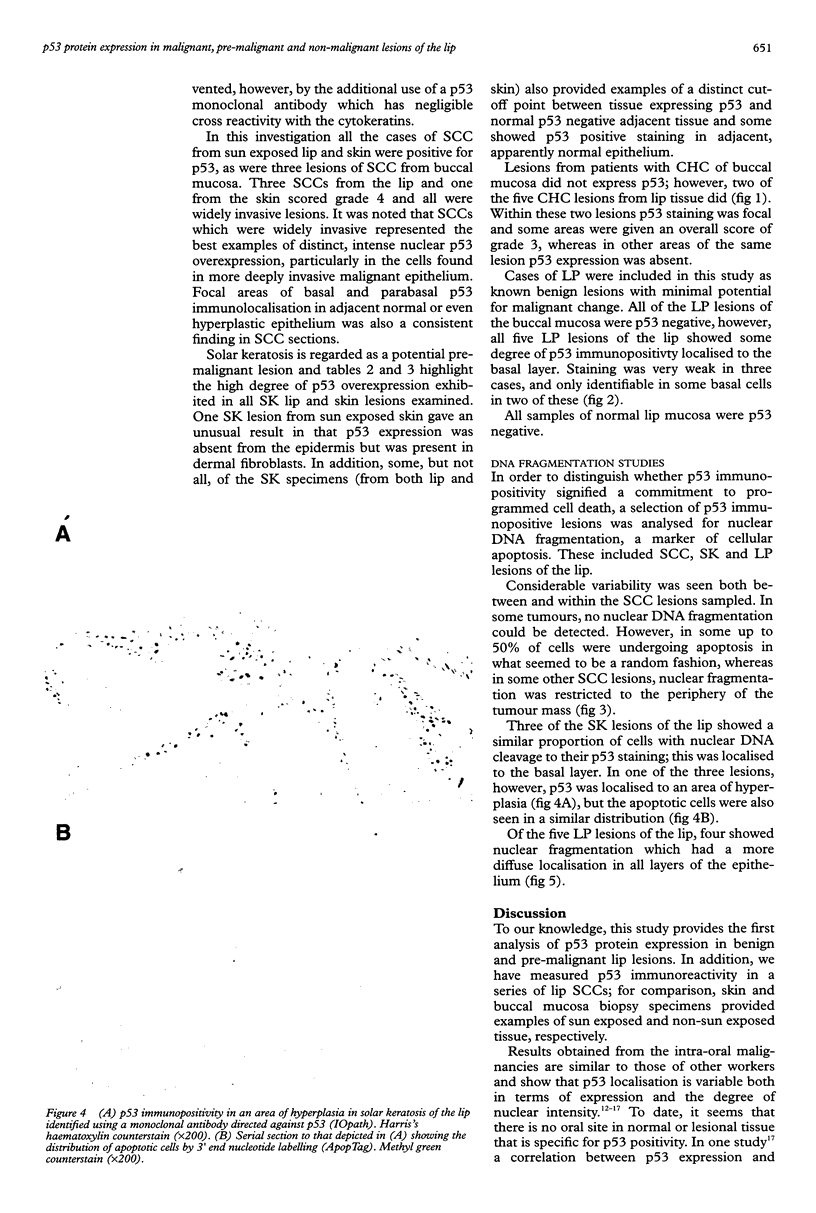
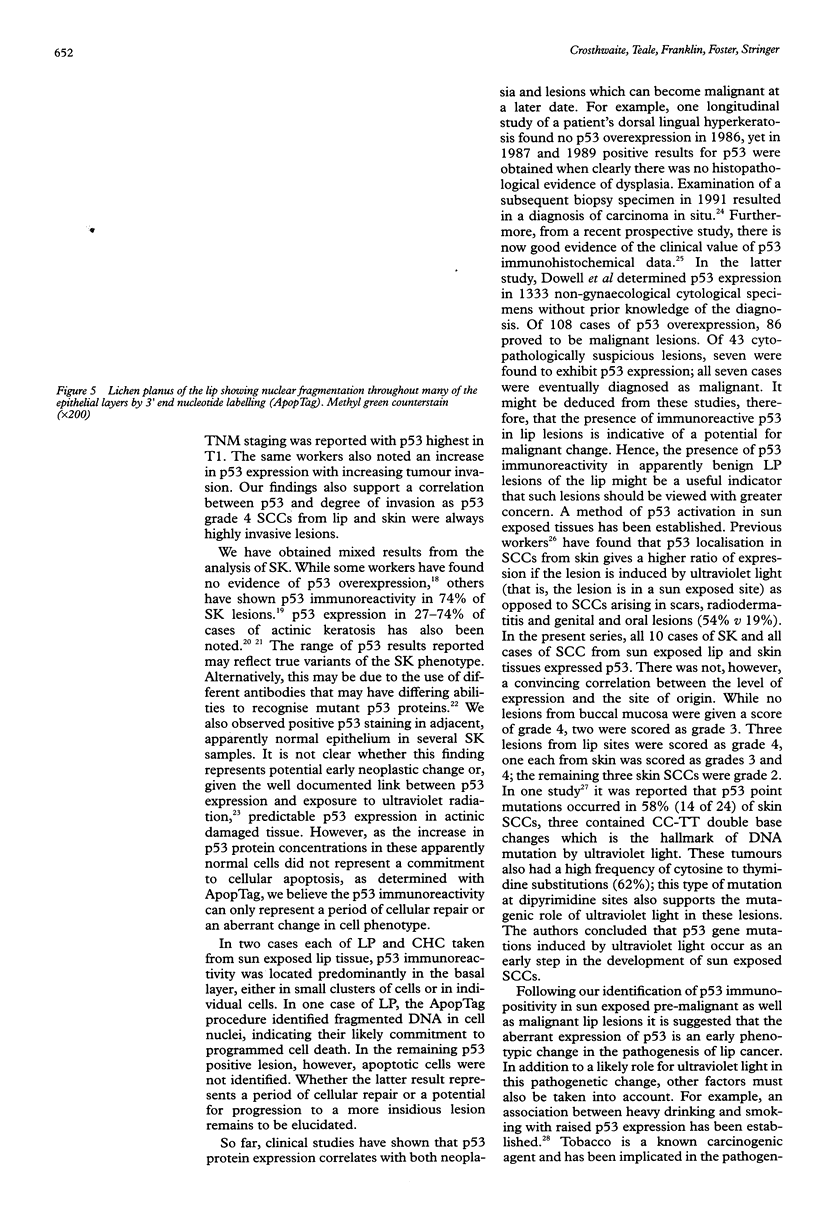
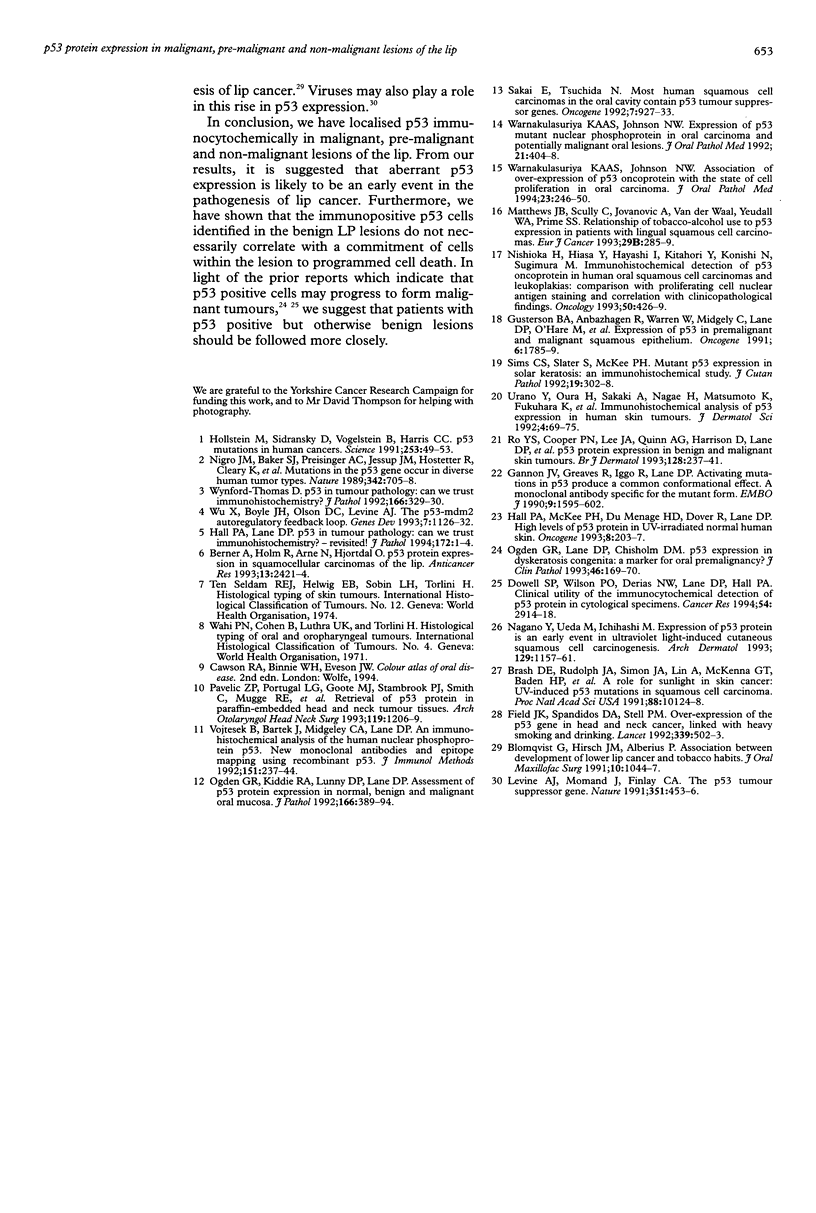
Images in this article
Selected References
These references are in PubMed. This may not be the complete list of references from this article.
- Berner A., Holm R., Naess A., Hjortdal O. p53 protein expression in squamocellular carcinomas of the lip. Anticancer Res. 1993 Nov-Dec;13(6B):2421–2424. [PubMed] [Google Scholar]
- Blomqvist G., Hirsch J. M., Alberius P. Association between development of lower lip cancer and tobacco habits. J Oral Maxillofac Surg. 1991 Oct;49(10):1044–1049. doi: 10.1016/0278-2391(91)90134-8. [DOI] [PubMed] [Google Scholar]
- Brash D. E., Rudolph J. A., Simon J. A., Lin A., McKenna G. J., Baden H. P., Halperin A. J., Pontén J. A role for sunlight in skin cancer: UV-induced p53 mutations in squamous cell carcinoma. Proc Natl Acad Sci U S A. 1991 Nov 15;88(22):10124–10128. doi: 10.1073/pnas.88.22.10124. [DOI] [PMC free article] [PubMed] [Google Scholar]
- Dowell S. P., Wilson P. O., Derias N. W., Lane D. P., Hall P. A. Clinical utility of the immunocytochemical detection of p53 protein in cytological specimens. Cancer Res. 1994 Jun 1;54(11):2914–2918. [PubMed] [Google Scholar]
- Field J. K., Spandidos D. A., Stell P. M. Overexpression of p53 gene in head-and-neck cancer, linked with heavy smoking and drinking. Lancet. 1992 Feb 22;339(8791):502–503. doi: 10.1016/0140-6736(92)91122-o. [DOI] [PubMed] [Google Scholar]
- Gannon J. V., Greaves R., Iggo R., Lane D. P. Activating mutations in p53 produce a common conformational effect. A monoclonal antibody specific for the mutant form. EMBO J. 1990 May;9(5):1595–1602. doi: 10.1002/j.1460-2075.1990.tb08279.x. [DOI] [PMC free article] [PubMed] [Google Scholar]
- Gusterson B. A., Anbazhagan R., Warren W., Midgely C., Lane D. P., O'Hare M., Stamps A., Carter R., Jayatilake H. Expression of p53 in premalignant and malignant squamous epithelium. Oncogene. 1991 Oct;6(10):1785–1789. [PubMed] [Google Scholar]
- Hall P. A., McKee P. H., Menage H. D., Dover R., Lane D. P. High levels of p53 protein in UV-irradiated normal human skin. Oncogene. 1993 Jan;8(1):203–207. [PubMed] [Google Scholar]
- Hollstein M., Sidransky D., Vogelstein B., Harris C. C. p53 mutations in human cancers. Science. 1991 Jul 5;253(5015):49–53. doi: 10.1126/science.1905840. [DOI] [PubMed] [Google Scholar]
- Matthews J. B., Scully C., Jovanovic A., Van der Waal I., Yeudall W. A., Prime S. S. Relationship of tobacco/alcohol use to p53 expression in patients with lingual squamous cell carcinomas. Eur J Cancer B Oral Oncol. 1993 Oct;29B(4):285–289. doi: 10.1016/0964-1955(93)90049-k. [DOI] [PubMed] [Google Scholar]
- Nagano T., Ueda M., Ichihashi M. Expression of p53 protein is an early event in ultraviolet light-induced cutaneous squamous cell carcinogenesis. Arch Dermatol. 1993 Sep;129(9):1157–1161. [PubMed] [Google Scholar]
- Nigro J. M., Baker S. J., Preisinger A. C., Jessup J. M., Hostetter R., Cleary K., Bigner S. H., Davidson N., Baylin S., Devilee P. Mutations in the p53 gene occur in diverse human tumour types. Nature. 1989 Dec 7;342(6250):705–708. doi: 10.1038/342705a0. [DOI] [PubMed] [Google Scholar]
- Nishioka H., Hiasa Y., Hayashi I., Kitahori Y., Konishi N., Sugimura M. Immunohistochemical detection of p53 oncoprotein in human oral squamous cell carcinomas and leukoplakias: comparison with proliferating cell nuclear antigen staining and correlation with clinicopathological findings. Oncology. 1993 Nov-Dec;50(6):426–429. doi: 10.1159/000227223. [DOI] [PubMed] [Google Scholar]
- Ogden G. R., Kiddie R. A., Lunny D. P., Lane D. P. Assessment of p53 protein expression in normal, benign, and malignant oral mucosa. J Pathol. 1992 Apr;166(4):389–394. doi: 10.1002/path.1711660411. [DOI] [PubMed] [Google Scholar]
- Ogden G. R., Lane D. P., Chisholm D. M. p53 expression in dyskeratosis congenita: a marker for oral premalignancy? J Clin Pathol. 1993 Feb;46(2):169–170. doi: 10.1136/jcp.46.2.169. [DOI] [PMC free article] [PubMed] [Google Scholar]
- Pavelic Z. P., Portugal L. G., Gootee M. J., Stambrook P. J., Smith C., Mugge R. E., Pavelic L., Wilson K., Buncher C. R., Li Y. Q. Retrieval of p53 protein in paraffin-embedded head and neck tumor tissues. Arch Otolaryngol Head Neck Surg. 1993 Nov;119(11):1206–1209. doi: 10.1001/archotol.1993.01880230048008. [DOI] [PubMed] [Google Scholar]
- Ro Y. S., Cooper P. N., Lee J. A., Quinn A. G., Harrison D., Lane D., Horne C. H., Rees J. L., Angus B. p53 protein expression in benign and malignant skin tumours. Br J Dermatol. 1993 Mar;128(3):237–241. doi: 10.1111/j.1365-2133.1993.tb00164.x. [DOI] [PubMed] [Google Scholar]
- Sakai E., Tsuchida N. Most human squamous cell carcinomas in the oral cavity contain mutated p53 tumor-suppressor genes. Oncogene. 1992 May;7(5):927–933. [PubMed] [Google Scholar]
- Sim C. S., Slater S., McKee P. H. Mutant p53 expression in solar keratosis: an immunohistochemical study. J Cutan Pathol. 1992 Aug;19(4):302–308. doi: 10.1111/j.1600-0560.1992.tb01366.x. [DOI] [PubMed] [Google Scholar]
- Urano Y., Oura H., Sakaki A., Nagae H., Matsumoto K., Fukuhara K., Nagae T., Arase S., Ninomiya Y., Nakanishi H. Immunohistological analysis of P53 expression in human skin tumors. J Dermatol Sci. 1992 Sep;4(2):69–75. doi: 10.1016/0923-1811(92)90061-f. [DOI] [PubMed] [Google Scholar]
- Vojtesek B., Bártek J., Midgley C. A., Lane D. P. An immunochemical analysis of the human nuclear phosphoprotein p53. New monoclonal antibodies and epitope mapping using recombinant p53. J Immunol Methods. 1992 Jul 6;151(1-2):237–244. doi: 10.1016/0022-1759(92)90122-a. [DOI] [PubMed] [Google Scholar]
- Warnakulasuriya K. A., Johnson N. W. Association of overexpression of p53 oncoprotein with the state of cell proliferation in oral carcinoma. J Oral Pathol Med. 1994 Jul;23(6):246–250. doi: 10.1111/j.1600-0714.1994.tb00053.x. [DOI] [PubMed] [Google Scholar]
- Warnakulasuriya K. A., Johnson N. W. Expression of p53 mutant nuclear phosphoprotein in oral carcinoma and potentially malignant oral lesions. J Oral Pathol Med. 1992 Oct;21(9):404–408. doi: 10.1111/j.1600-0714.1992.tb01028.x. [DOI] [PubMed] [Google Scholar]
- Wu X., Bayle J. H., Olson D., Levine A. J. The p53-mdm-2 autoregulatory feedback loop. Genes Dev. 1993 Jul;7(7A):1126–1132. doi: 10.1101/gad.7.7a.1126. [DOI] [PubMed] [Google Scholar]
- Wynford-Thomas D. P53 in tumour pathology: can we trust immunocytochemistry? J Pathol. 1992 Apr;166(4):329–330. doi: 10.1002/path.1711660402. [DOI] [PubMed] [Google Scholar]






